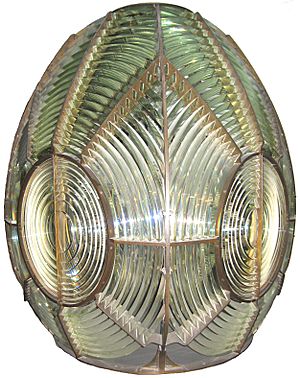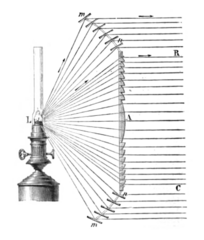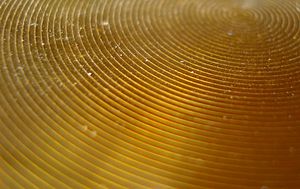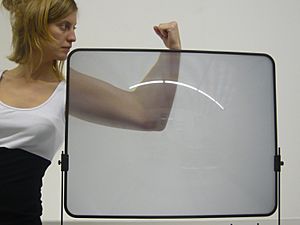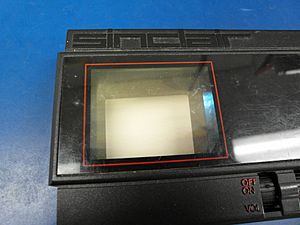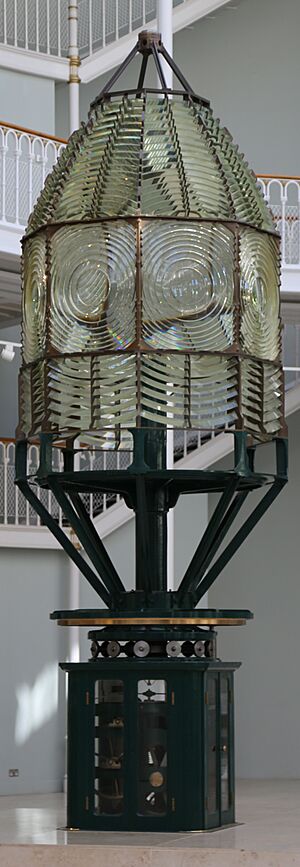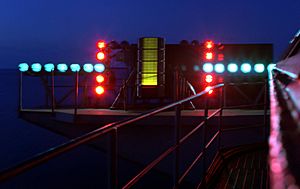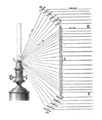Fresnel lens facts for kids
A Fresnel lens (pronounced fray-NELL) is a special type of optical lens. It was first created for Lighthouses. This amazing lens is named after its inventor, a French physicist named Augustin-Jean Fresnel. Before Fresnel, other scientists like Buffon and Condorcet had similar ideas for making big burning lenses.
The unique design of a Fresnel lens allows it to be very large and powerful without being heavy or thick. Compared to older lenses, a Fresnel lens is much thinner. This means more light can pass through it. Lighthouses using these lenses could shine their light much farther, making them safer for ships.
Contents
How a Fresnel Lens Works
2: Cross section of a normal plano-convex lens with the same power
A Fresnel lens works by dividing a normal lens into many small, circular sections. Imagine cutting a regular lens into rings and then flattening each ring. This design greatly reduces the amount of material needed. It makes the lens much thinner than a traditional lens of the same size and power.
Each section of a Fresnel lens has a slightly different angle. This helps to bend the light correctly. Some Fresnel lenses even replace the curved surfaces with flat ones. These lenses act like many tiny prisms arranged in a circle. The prisms at the edges are steeper, while the center might be flat or slightly curved.
Early Fresnel lenses were made from separate prisms. Later, "single-piece" Fresnel lenses were created. These were used in things like car headlamps. Today, special computer-controlled machines can make very complex Fresnel lenses.
Even though Fresnel lenses save space and weight, they don't always create the sharpest images. That's why cameras and other devices needing very clear pictures often use traditional lenses.
Fresnel lenses can be made from glass or plastic. They come in many sizes. Some are huge, like those in old lighthouses, while others are tiny, found in cameras or reading aids. Many modern Fresnel lenses are very thin and flat, sometimes even flexible. They can be just a few millimeters thick.
What Are Fresnel Lenses Used For?
Helping You See Better
Fresnel lenses are often used as simple magnifiers that you can hold in your hand. They also help people with certain eye problems, like strabismus (crossed eyes). In the past, they were used to make the screens of small CRT televisions look bigger, like the Sinclair TV80.
You can also find Fresnel lenses in traffic lights. They help direct the light so drivers can see the signals clearly.
Improving Vehicle Safety
Some large trucks use Fresnel lenses on their passenger-side windows. This helps drivers see blind spots, especially when driving in countries where they sit on the opposite side of the cab (like a left-hand-drive truck in the UK).
Another use in vehicles is as a rear-view helper. A Fresnel lens attached to the back window can give a wide view of what's behind the vehicle. This is very useful for tall or boxy vehicles, as it helps the driver see more than just a regular rear-view mirror.
Fun and Entertainment
Fresnel lenses have even appeared in movies and performances! The musician Peter Gabriel used them in his shows to make his head look much bigger for a funny effect. In the movie Brazil, plastic Fresnel screens were used to make small computer monitors look larger. They also sometimes distorted the scene in a humorous way. In the Pixar movie Wall-E, a Fresnel lens helps the robot watch a musical on an iPod.
Photography and Cameras
Canon and Nikon use Fresnel lenses in some of their camera lenses. This helps them make powerful telephoto lenses much shorter and lighter than traditional designs. Nikon calls their version "Phase Fresnel."
The Polaroid SX-70 camera used a Fresnel reflector as part of its viewing system. Also, large cameras used by professional photographers sometimes have a Fresnel lens. It makes the image on the camera's focusing screen brighter, which helps photographers set up their shots.
Lighting Up the World
High-quality glass Fresnel lenses were very important in lighthouses during the late 1800s and early 1900s. Most are no longer in use today. Lighthouse Fresnel lenses often had extra prisms above and below the main lens. These prisms helped gather all the light from the lamp. They could even use Total internal reflection to make the light brighter. These lenses allowed lighthouses to send light much farther and in specific patterns, which helped sailors know where they were.
For a long time, Fresnel lenses were also common in car headlamps. They helped shape the light beam to meet different driving needs. Newer cars now use different technology, but Fresnel lenses are still used in car tail lights and other signal lights.
In theatre and movie production, lighting equipment often uses Fresnel lenses. These lights are simply called "Fresnels." They can make a light beam very narrow or very wide. The Fresnel lens creates a soft-edged beam of light, which is great for lighting up a large area evenly.
Aircraft carriers use Fresnel lenses in their optical landing systems. These systems help pilots land safely on the ship. Lights made with Fresnel lenses show the pilot if they are too high, too low, or just right for landing.
Fresnel lenses are also used in passenger reading lights on Airbus airplanes. They focus the light so it doesn't bother other passengers in a dark cabin.
Projecting Images
Fresnel lenses are used in overhead projectors and projection televisions. While they might not give the sharpest image, they are much lighter and cheaper than traditional lenses for these uses. They help focus the light from a lamp through the image you want to project.
Harnessing Solar Power
Since plastic Fresnel lenses can be made very large, cheap, and light, they are perfect for concentrating sunlight. They are used in solar cookers to heat food and in solar collectors to heat water for homes. They can also help generate steam or power special engines using the sun's energy.
Fresnel lenses can focus sunlight onto solar cells, making the sunlight almost 500 times stronger! This means you need less expensive solar cell material to produce the same amount of electricity. In recent years, Fresnel lenses have also been used in large concentrating solar power (CSP) plants to create energy.
Images for kids
-
Cape Meares Lighthouse; a first-order Fresnel lens
-
First-order group-flashing Fresnel lens, at the Point Arena Lighthouse Museum, Point Arena Lighthouse, Mendocino County, California. This lens created three double-flashes per rotation.
-
A third-order lens (St. Simons Island Light)
-
A fourth-order lens (Sekizaki Lighthouse, Oita, Japan)
-
A fifth-order lens (Jones Point Light)
-
A sixth-order lens (Ponce de Leon Inlet Light)
See also
 In Spanish: Lente de Fresnel para niños
In Spanish: Lente de Fresnel para niños


